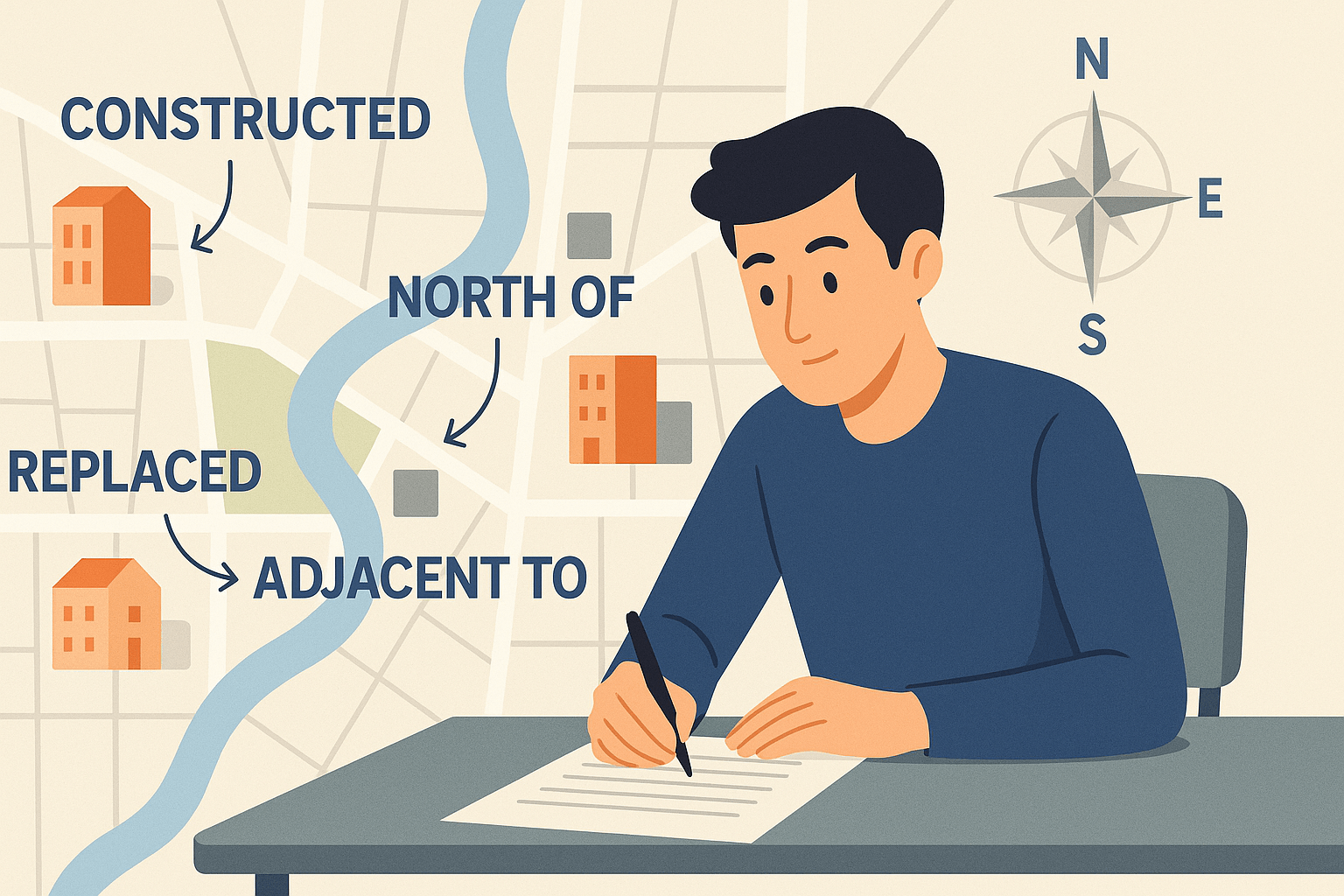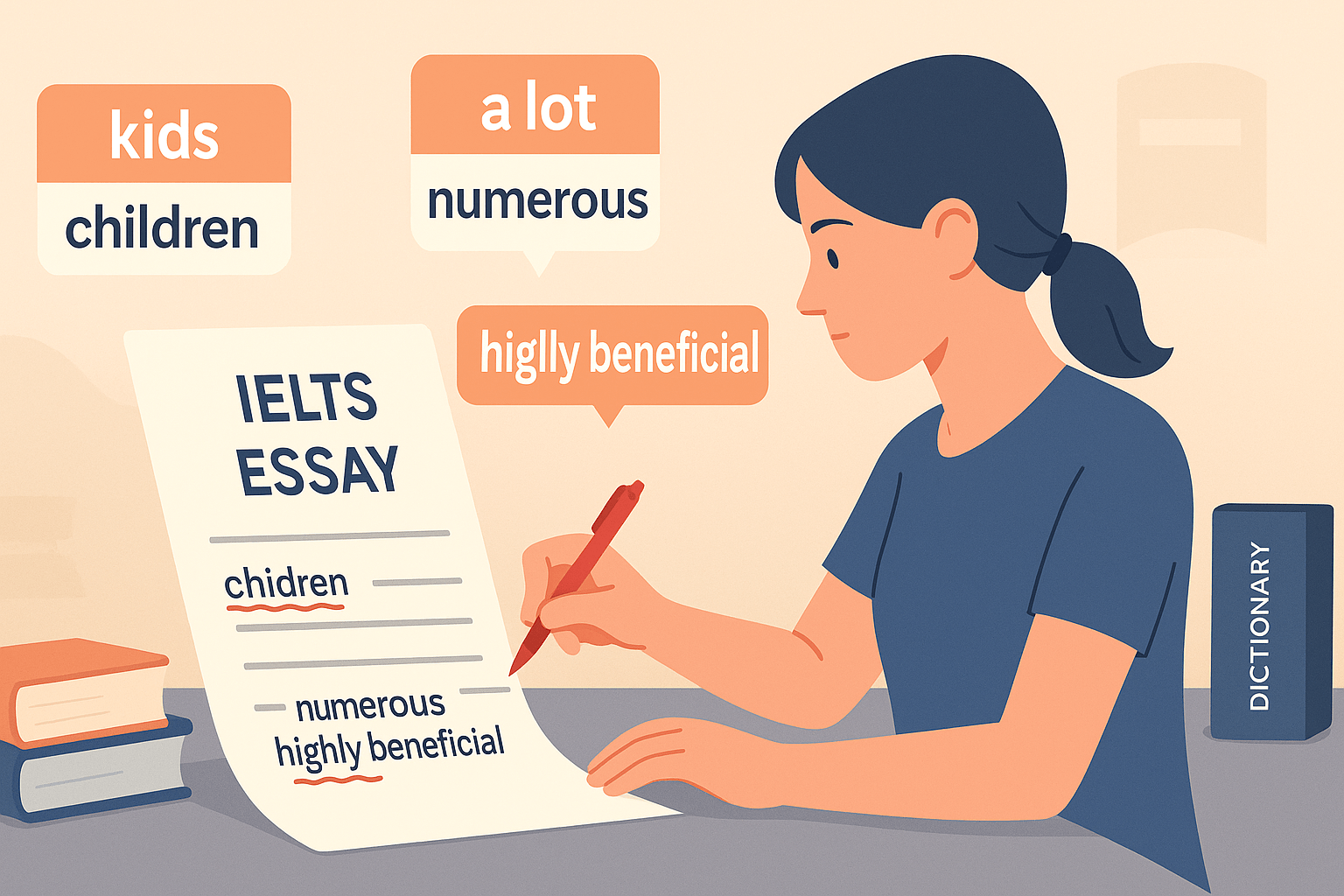- Why IELTS Map Vocabulary Matters
- 1. Action Verbs for Describing Map Changes
- 2. Prepositions for Locations on Maps
- 3. Directional Phrases for Spatial Awareness
- 4. Real Student Story: Mei’s Map Makeover
- 5. Step-by-Step Strategy to Describe IELTS Maps
- 6. Final Tips for Band 7+ IELTS Map Writing
- External Resources
If you’ve ever looked at an IELTS Writing Task 1 map and thought: “What do I even write?”
You’re not alone!
Many of my students initially struggle with IELTS Map vocabulary, because map questions test more than just grammar — they test your ability to describe location, change, and layout accurately and naturally.
Without the right vocabulary, it’s easy to repeat simple words like “built” or “added” over and over, which can limit your Lexical Resource score.
In this guide, I’ll teach you the exact IELTS map vocabulary I give my Band 7+ students. You’ll learn:
- ✅ The best action verbs for describing changes on maps
- ✅ Prepositions and location words that make your writing clear
- ✅ Directional phrases to show spatial awareness
- ✅ A step-by-step strategy for writing high-band map answers
If you want to master all IELTS Task 1 visuals, check out my Complete Writing Task 1 Vocabulary Guide — this is the pillar resource that ties all charts, tables, and maps together for Band 7+.
Why IELTS Map Vocabulary Matters
IELTS Writing Task 1 maps are about clear description, not creativity.
Examiners are looking for:
- Varied and precise vocabulary
- Logical comparisons and descriptions
- Formal, academic tone
If your answer looks like this:
“They built a road. They built a park. They added a house.”
…it will likely stop at Band 6, because it lacks variety and cohesion.
Instead, by using IELTS Map vocabulary like constructed, replaced, converted, and extended, your answer becomes:
“A new residential area was constructed to the north of the park, replacing the small shop that was previously there.”
This sounds formal, precise, and examiner-friendly — exactly what you need for Band 7+.
1. Action Verbs for Describing Map Changes
The most powerful way to upgrade your IELTS map answer is to replace basic verbs with academic alternatives.
Here are my top verbs for describing map changes:
- Constructed – “A shopping centre was constructed in the north-east corner.”
- Demolished – “The old factory was demolished to make way for new housing.”
- Replaced – “Farmland was replaced by a residential zone.”
- Extended – “The main road was extended to reach the town centre.”
- Converted – “The school was converted into a community centre.”
- Developed – “The area to the west was developed into a commercial district.”
- Expanded – “The airport expanded to include a second runway.”
- Removed – “The playground was removed and replaced with a car park.”
- Renovated – “The theatre was renovated to modern standards.”
Teacher Tip:
- Use passive voice because we often don’t know who made the changes:
- ✅ “A bridge was built across the river.”
- ❌ “They built a bridge.”
This automatically makes your description more formal and academic.
2. Prepositions for Locations on Maps
Clear location vocabulary helps the examiner visualize the map.
Here are essential prepositions for IELTS map tasks:
- Next to – “The café is located next to the post office.”
- Opposite – “The school was built opposite the supermarket.”
- Behind – “A car park was added behind the cinema.”
- Adjacent to – “The hotel was constructed adjacent to the beach.”
- At the corner of – “A police station was introduced at the corner of Main Street and Oak Lane.”
- Surrounded by – “The garden was surrounded by newly built apartments.”
Pro Tip:
Use a mix of simple and formal prepositions to sound natural and fluent.
3. Directional Phrases for Spatial Awareness
If your map has a compass rose, you can score higher by including north/south/east/west directions.
Examples of Directional Language:
- To the north of – “A new industrial estate was developed to the north of the river.”
- In the south-west corner – “The park was replaced by houses in the south-west corner.”
- Along the river – “A footpath was added along the riverbank.”
- Between X and Y – “A shopping centre was constructed between the library and the sports complex.”
- At the southern edge – “The farm was removed at the southern edge of the village.”
Student Upgrade Example:
- ❌ “There is a hospital near the road.”
- ✅ “A hospital was constructed to the east of the main road, adjacent to the school.”
This is exactly the kind of clarity and variety examiners reward.
4. Real Student Story: Mei’s Map Makeover
To show you how powerful IELTS map vocabulary can be, let’s look at Mei’s journey from Band 6.0 to 7.5:
- Before:
“They added a road. They added a library. They built a park.” - After learning map vocabulary:
“A new library was constructed to the west of the park, replacing the row of houses that was previously there.”
What changed?
- ✅ Used passive voice
- ✅ Added directional language
- ✅ Replaced basic verbs with academic alternatives
This variety and precision immediately increased her Lexical Resource score.
5. Step-by-Step Strategy to Describe IELTS Maps
Follow this 4-step approach to organize your Task 1 map answers:
Step 1: Identify Main Changes
- What was added, removed, replaced, or expanded?
Step 2: Choose Accurate Vocabulary
- Use verbs + passive voice (constructed, demolished, replaced)
- Add prepositions and directional phrases
Step 3: Group and Compare Logically
- Organize your description by location or type of change
- Use linking phrases like “Meanwhile” or “In contrast” for cohesion
Step 4: Review for Variety
- Scan for repeated words like added or built
- Replace with stronger verbs and modifiers
6. Final Tips for Band 7+ IELTS Map Writing
Here’s my checklist for success:
- ✅ Use 4–6 strong map-specific verbs
- ✅ Include prepositions and directional language
- ✅ Use passive voice naturally
- ✅ Group logically for clear cohesion
- ✅ Avoid repeating basic verbs like added or built
Free Resource:
Download our Map Vocabulary Infographic with 25+ words and real examples to stick by your desk for practice.
External Resources
- IELTS.org – Official IELTS site with format & samples
- British Council – Free prep and tips
- IDP IELTS – Test booking and practice materials
Takeaway:
IELTS Map vocabulary is the bridge between your ideas and a clear, high-band response.
Master these verbs, prepositions, and directional phrases — and you’ll write cohesive, academic, and Band 7+ map descriptions every time.





2 Responses